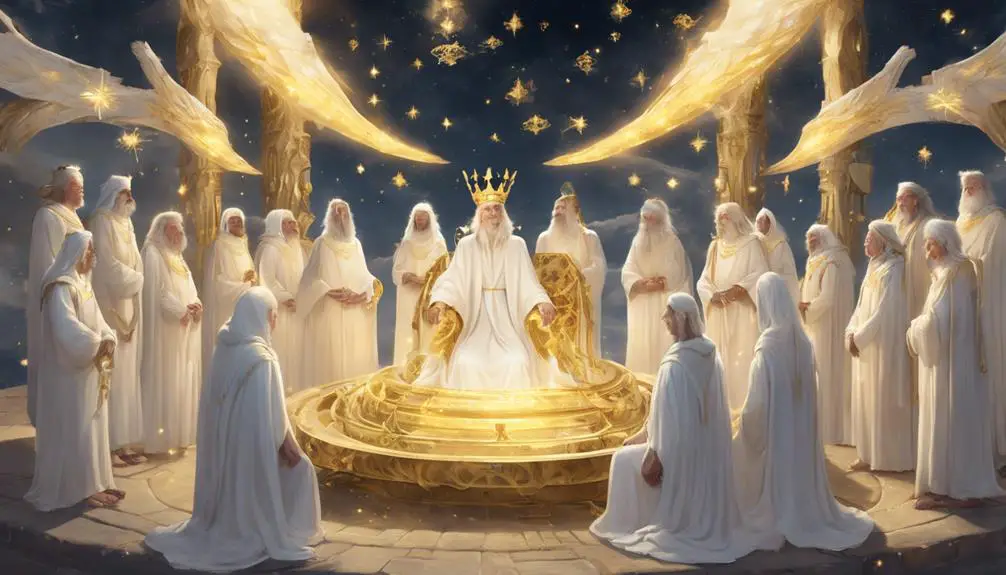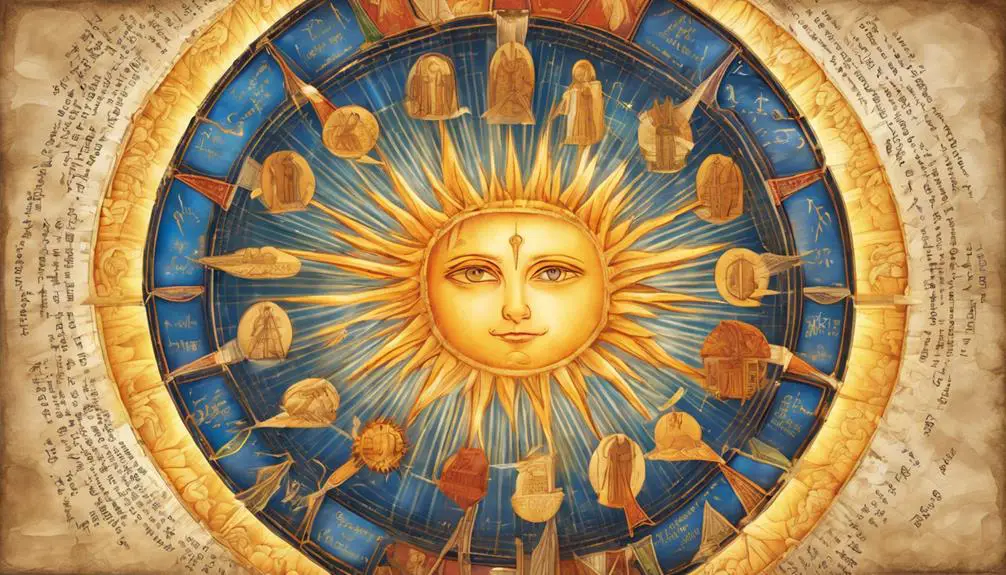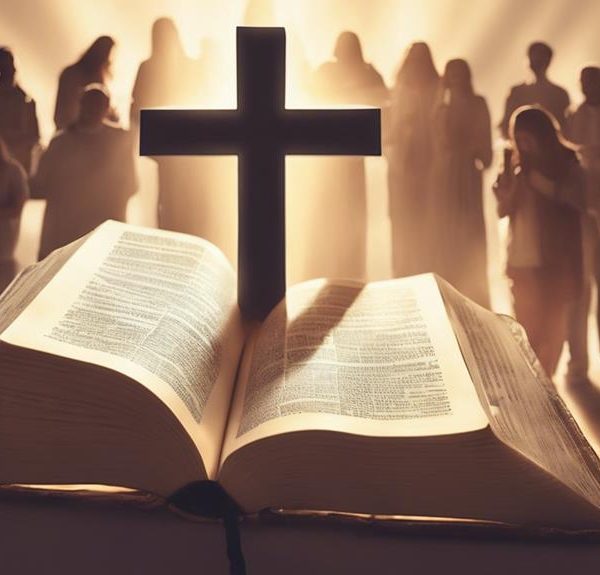Intriguingly, the number 24 in the Bible symbolizes divine order and completeness, uncover its profound impact on biblical narratives and prophecies.

What Does the Number 24 Mean in the Bible
Imagine you're exploring the mysterious imagery of Revelation and stumble upon the 24 elders seated around the throne. This isn't just a random detail; it's a key to understanding deeper biblical symbolism.
The number 24 surfaces throughout the Bible, from the divisions of priestly services to the measurements of the temple, hinting at themes of completeness and divine order.
As you ponder the significance of this number, consider how it weaves through prophetic timelines and sacred structures, inviting you to uncover layers of meaning that could reshape your interpretation of ancient texts.
Why might this numeral hold such weight in the scriptural narrative? The answer could offer a fresh lens through which to view the entirety of biblical history.
Key Takeaways
- The number 24 symbolizes divine governance and worship, as seen in the depiction of the 24 elders in Revelation.
- It represents completeness and divine order, reflecting the structured universe under God's control.
- The division of priestly services into 24 groups underscores the principle of continuous worship and divine organization.
- In prophetic contexts, 24 relates to divine timelines and the fulfillment of biblical prophecies, indicating meticulous divine planning.
The 24 Elders in Revelation

In the book of Revelation, the 24 elders symbolize a significant aspect of apocalyptic imagery, representing divine governance and worship in the heavenly realm. These figures, often referred to as elderly representations, embody wisdom and authority, which are vital attributes in the structure of heavenly governance. Their presence around the throne of God isn't merely ornamental but underscores their role in the celestial hierarchy, acting as intermediaries between the divine and the multitude of beings in the cosmos.
The concept of the 24 elders holds deep symbolic value, intricately linked with ideas of order, balance, and sanctity within the divine realm. Their depiction, seated on thrones and adorned in white garments, with golden crowns on their heads, conveys a message of purity, victory, and sovereignty. This imagery reinforces the notion of their seniority and governance, acting as a testament to their role in the administration of heavenly affairs.
Priestly Divisions and Services
Shifting focus to the earthly realm, the concept of Priestly Divisions and Services illuminates another layer of structured divine worship, as outlined in the Hebrew Bible. This organization within the temple reflects a meticulous system established for the descendants of Aaron, ensuring that the Aaronic lineage was directly involved in religious ceremonies and the day-to-day operations of the sanctuary. These divisions underscore the significance of the Levitical roles, providing a framework through which the sacred duties were allocated and performed.
- Aaronic Lineage: Central to the priestly divisions, this lineage determined who could serve in the temple, maintaining a direct link to Aaron, the brother of Moses.
- Levitical Roles: Levites assisted the priests, taking on various responsibilities within the temple, from maintenance to music.
- Structured Worship: The divisions facilitated a continuous cycle of worship and sacrifices, ensuring that the temple was always attended.
- Divine Order: This system exemplified a divine order, reflecting the importance of organization and hierarchy in worship practices.
In essence, these priestly divisions and services represented a physical manifestation of divine order, meticulously organized to honor the covenant between God and the Israelites, ensuring that worship remained a central and unceasing aspect of their community life.
Symbolism in Temple Measurements

Frequently, the measurements of the temple hold profound symbolic meanings, reflecting deeper spiritual truths and divine principles. When you delve into temple architecture, you're not just exploring a physical structure but unlocking a world where every cubit and span is laden with significance. This domain of sacred geometry serves not only as a foundation for the physical edifice but also as a blueprint for spiritual enlightenment.
The dimensions and proportions found in temple design are meticulously chosen to embody theological concepts and the divine order of the universe. For instance, specific measurements can symbolize completeness, perfection, or the harmonious relationship between the divine and the earthly. In this context, understanding the symbolism behind these measurements isn't just an academic exercise—it's a journey into the heart of spiritual symbolism and its manifestation in material form.
As such, the study of these measurements goes beyond mere numerology or architectural appreciation. It's a profound exploration of how sacred geometry acts as a bridge between heaven and earth, encoding eternal truths within the very walls and spaces of the temple. This approach allows you to appreciate the temple not just as a historical or religious site but as a living, breathing manifestation of divine principles.
24 and the Prophetic Calendar
The prophetic calendar's intricate design reveals a meticulous alignment with biblical prophecies and events, serving as a key to understanding divine timelines. This calendar, deeply embedded within the scriptures, offers insights into the unfolding of God's plan for humanity. It's not merely a chronological account; it's a divine tool that bridges the past, present, and future.
When exploring the prophetic calendar, consider these crucial elements:
- Daniel's weeks: A prophetic timeline that unfolds in seventy weeks, each symbolizing a year, pointing towards significant eschatological events.
- Apocalyptic visions: These visions, often rich with symbolism, offer glimpses into the future, revealing God's ultimate plan for creation.
- Historical fulfillments: Historical events that align with biblical prophecies, validating the accuracy and divine inspiration of the Bible.
- Future predictions: Prophecies yet to be fulfilled, offering believers hope and anticipation of God's continued involvement in human affairs.
The prophetic calendar, with its foundations in Daniel's weeks and apocalyptic visions, serves not only as a testament to the Bible's divine origin but also as a guide for believers navigating through times of uncertainty. It underscores the Bible's role as a timeless and relevant source of wisdom and insight.
Completeness and Divine Order

In biblical numerology, 24 symbolizes both completeness and divine order, reflecting a structured universe under God's sovereign control. This number serves as a profound emblem of God's authority and the cosmic balance He maintains throughout creation. By examining the scriptures, you'll find that the representation of 24 isn't arbitrary but deeply embedded in the fabric of biblical tradition.
For example, the Book of Revelation speaks of 24 elders seated around God's throne, embodying the fullness of God's people and His unchallengeable rule over the cosmos. This imagery isn't merely symbolic; it underscores the meticulous order and completeness that God instills in the universe. The presence of 24 elders signifies a divine governance that's both comprehensive and perfectly balanced, reflecting God's ultimate authority over creation.
Frequently Asked Questions
How Is the Number 24 Connected to King David's Leadership and Governance in the Bible?
In your exploration of King David's leadership and governance, you'll find the number 24 indirectly linked through symbolic events and decisions.
For instance, David's harp, signifying spiritual leadership, and his victory in the Goliath battle, reflecting military prowess, both contribute to a narrative of balanced governance.
These aspects, while not directly connected to the number 24, offer a framework for understanding his comprehensive leadership approach, blending spiritual guidance with decisive action in governance.
Are There Any Lesser-Known Characters or Stories in the Bible Associated With the Number 24 That Offer Unique Insights or Lessons?
Yes, beyond the well-trodden paths, the Bible harbors tales where the number 24 gleams like a hidden gem. Specifically, the 24 elders symbolism and the Priestly divisions offer profound insights. These elements serve as a microcosm, revealing the structured nature of divine governance and worship.
Analytically, they underscore the meticulous organization within the celestial realm and its earthly reflection, inviting a deeper contemplation of order and dedication in spiritual practice.
How Does the Number 24 Relate to the Concept of Faith and Perseverance in the Biblical Narrative?
You'll find that the number 24 symbolizes faith and perseverance through its association with priestly garments and Sabbath observance. These elements serve as constant reminders of dedication and steadfastness in one's beliefs.
The priestly garments, worn by the 24 priestly divisions, represent a continuous commitment to spiritual service, while the Sabbath observance, occurring every seventh day, reinforces the importance of resting in faith and reflecting on perseverance.
Can the Number 24 Be Found in the Structure or Patterns of Biblical Poetry and Songs, and What Significance Does It Hold There?
You're diving into a treasure trove when you explore the musical structure and poetic symbolism of biblical texts.
The number 24 mightn't leap off the page in neon lights, but its presence in the underlying architecture of biblical poetry and songs is subtly profound.
Analyzing these elements reveals a tapestry where 24 symbolizes completeness and divine order, enhancing the text's richness and offering scholars a deeper layer of interpretation.
Is There a Correlation Between the Number 24 and the Appearances or Mentions of Angels in the Bible Outside of the Context of Revelation?
You're exploring the presence of the number 24 and its connection to angels outside Revelation's context.
It's worth noting that while the Bible doesn't explicitly link 24 to angel hierarchy or priestly divisions in a numerical sense, the structure and symbolism often point towards order and completeness.
This suggests a deeper, perhaps non-literal, association rather than a direct correlation.
Scholarly analysis encourages looking beyond surface numbers to understand thematic and symbolic connections in biblical texts.
Conclusion
In conclusion, the number 24 in the Bible signifies much more than a mere numeral. It embodies the divine order and completeness, from the 24 elders in Revelation to the priestly divisions. This number intricately weaves through the prophetic calendar and temple measurements, demonstrating a celestial symmetry.
Understanding its implications is akin to fitting a key piece into the biblical puzzle, offering a clearer vision of the scriptural tapestry. Its consistent presence underlines a divine design, emphasizing harmony and perfection in the spiritual realm.



Sign up